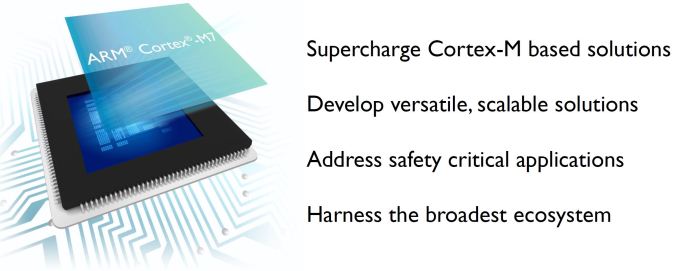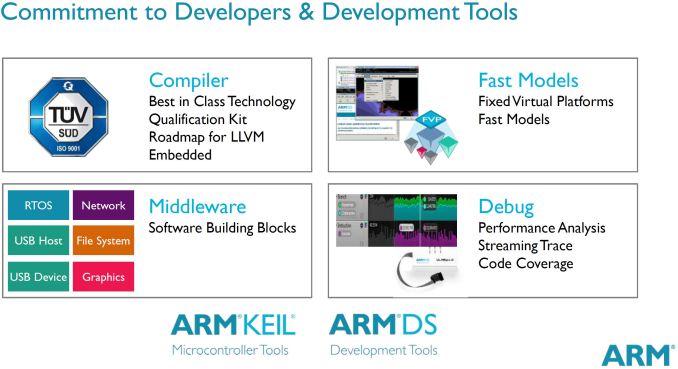Cortex-M7 Launches: Embedded, IoT and Wearables
by Stephen Barrett on September 23, 2014 7:01 PM ESTFinal Words
In the past two days we have seen two announcements targeting IoT and wearable devices from major semiconductor companies. These announcements may seem premature as there hasn’t been a game changing device release like the original iPhone was, but the companies involved are simply doing what they have done before and investing in the future. Much of ARMs work before the ARM11 processor was behind closed doors or simply unnoticed by consumers at large, but it was there. Watching the suppliers evolve to provide suitable products, documentation, and tooling for something new is exciting.
The Coretex-M7 processor pushes the performance of ARMs dedicated MCU line to new levels, helping ARM further consolidate MCUs and DSPs into a single ARM ISA compatible 32-bit CPU. The increased performance and features also allow device makers to rely more on the always on MCU and power up the AP much less often, improving overall power consumption and even enabling devices that were previously impractical.
ARM also invested in improving the interrupt latency of the M7 and provides qualification kits for safety critical standards like ISO 26262 (automotive) and IEC61508. Anyone with experience here knows just how expensive creating these kits can be.
For major MCU SoC vendors like ST, Atmel, NXP, Freescale, TI, and others, the prospect of integrating a CPU core off-the-shelf from ARM means less R&D investment in processor design and documentation with a potentially greater payoff by tapping into the ARM ecosystem. Additionally, rather than hand coding their own development IDEs and compilers, they can serve their users with existing open source alternatives. To consumers, consolidation could bring similarities to the Windows + Intel days when software developers gained immense efficiency.
Many IoT and wearable devices today accomplish their roles using high power A series application processors. This is by design, as the companies providing them simply reused their smartphone processors to get product to market as fast as possible. Designing a heterogeneous system using MCUs and application processors is more complex but the benefits are undeniable. As the IoT and wearable devices mature, we will keep a close eye on the underlying technology of future devices and hope to report some positive changes over the next year.












43 Comments
View All Comments
nathanddrews - Wednesday, September 24, 2014 - link
For as often as my phone, computer, stove, and microwave all get out of sync, you'd think we humans haven't yet mastered the whole "tracking of time" thing. Most of my devices are supposed to auto-update online, but that doesn't excuse the poor time-keeping of modern devices in between updates. Smart watch? Doubtful.markmuehlbauer - Wednesday, September 24, 2014 - link
Good point. 2014 and where are standards for this across all devices? The only devices that are truly accurate subscribe to a network time protocol (NTP) service.How about we recycle amplitude modulated carriers toward a narrow band digital signal broadcast NTP service. Then every device out there can have a simple AM loop antenna in it to "listen" to the NTP service and update. Of course this would require the FCC and IEEE to actually work together. Sigh. . .
otherwise - Wednesday, September 24, 2014 - link
There are already at least two ways to get a reference timestamp over the air. First is GPS, which will get you accurate timestamps into the sub-millisecond domain, which is why you see GPS devices in data centers usually as a stratum0 NTP device and/or a PTP Master. The second is WWVB operated by the NIST, which broadcasts reference timestamps at the 60KHz band. If you have an alarm clocks that sets itself this is probably the source it uses.makerofthegames - Tuesday, September 23, 2014 - link
So for my own understanding of roughly how powerful these are, what x86 processor would you say they're most comparable to? From the general architecture they look like a first-gen P5 Pentium, minus the MMU (and optionally minus the cache and FPU). Would that be an accurate analogy?jdesbonnet - Tuesday, September 23, 2014 - link
It's hard to directly compare MCUs to application processors. They have different types of tasks. Application processors are about computational throughput and you pay for that in enormous gate counts (=area=cost) and energy consumption. Eg the quad core Intel Xeon I'm using right now has a gate count in excess of 2G gates. By comparison a small Cortex M0 will have as few as 12K gates and can run tasks such as wireless security sensors for years on end from a single coin cell battery. Also MCUs facilitate deterministic code execution where timing of events is critical (eg detect car crashing -> deploy airbag). For benchmarks look a this table: http://en.wikipedia.org/wiki/Instructions_per_seco... Seems a ARM Cortex M0 at 50MHz is somewhere between an Intel 486DX and the original Pentium.makerofthegames - Tuesday, September 23, 2014 - link
Yeah, it's never going to be an exact comparison. I pulled the P5 guess from the architecture - both P5 and M7 are in-order, two-issue superscalar with two main integer paths and an FPU. And while their goals were very different, they both were very constrained for transistors (by current standards), so I figured they might have some level of comparison.wetwareinterface - Wednesday, September 24, 2014 - link
the nearest comparison to an x86 processor is the new intel edison. however where this will excel at certain tasks the edison will excel at others.to break it down any task that is memory bandwidth constrained will be better on edison.
any task that is latency critical and served best by an interrupt (the car crash airbag analogy above serves well) is better performed on the m7.
any task that is math based, requires simple calculations, and parallel execution or reordering on the fly of the task being performed is done frequently then the m7 would be a good choice with the inclusion of the dsp. an example of this is manipulation of incoming audio or video data in response to user input (examples like a guitar pedal for audio or video mixing effects like on a club's screens).
the simple fact is there's no perfect "one solution".
what one does better the other does worse and no processor is best in all catagories
Stephen Barrett - Wednesday, September 24, 2014 - link
edison isnt so much a processor as it is a SoM or system on module. It contains an atom silvermont applications processor (AP) and an Intel Quark microcontroller (MCU).HardwareDufus - Tuesday, September 23, 2014 - link
hmmm.. they are a risc based architecture (armv7 ISA), so they wouldn't have as high as an IPC as a cisc based architecture like pentium. however this cortex-m7 mcu is more a soc than just a straight processor like the pentium was. hard to say as the workloads are so absolutely different.BTW, with the embargo lifted.... ARM just updated their website:
http://arm.com/products/processors/cortex-m/cortex...
http://arm.com/Cortex-M7-chip-diagramLG.png
will be exciting to watch some of the initial development & prototyping boards introduced by some of the big players (ti, stmicroelectronics and atmel) to see what native capabilities they break out.
hopefully ethernet, sdio, jtag, and multiple channels of uart, can, spi, i2c/twi, dac are givens. would love a basic lcd interface too.
Wilco1 - Tuesday, September 23, 2014 - link
No, by definition RISCs have better IPC than CISCs, not the other way around (on a RISC pretty much every instruction executes in a single cycle, unlike the complex CISC instructions). Studies have shown x86 and ARM actually do the same amount of work per instruction due to x86 compilers avoiding the complex instructions (this observation is why RISC exists!), and ARM doing a lot of work per instruction (compared to other RISCs - such as allowing shift+add as a single instruction, conditional execution, load/store multiple). This effectively means any IPC difference is not due to ISA but due to microarchitecture.Looking at the Dhrystone results, the M7 is a bit faster than A7, so should obliterate Quark, beat an old Pentium and do well against Silverthorne at similar frequency.